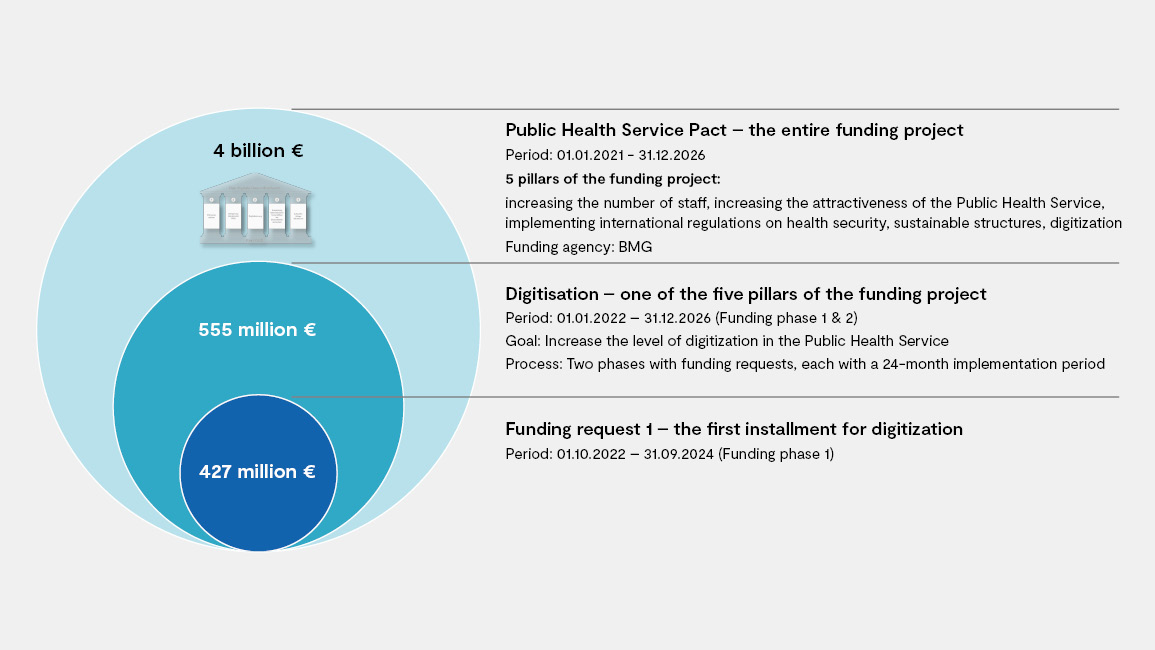The general public often takes little notice of the activities going on under the umbrella of public health service (PHS). Although many people have contact with its offers, they remain unaware of the exact relationships — preventive health care is a good example. PHS is charged with the protection of the health of the country’s citizens. A lack of funding, the pandemic, and the demands of digitalization, however, present major challenges to the sector. The “Pact for PHS” agreed by the federal and state governments seeks to remedy this situation by budgeting four billion euros for the service.
Lack of funds in public health service has resulted in insufficient personnel and inadequate infrastructure. The coronavirus pandemic in 2020, the shortage of staff, and the low level of digitalization have obviously added further burdens to the already heavy workloads, and even the general public has taken note of the development. The issue is nothing new, however; the lung disease SARS, avian flu, and the A H1N1 influenza outbreak posed major challenges to public health departments in the past. As early as 2009, extensive efforts were required to meet the public’s clamoring for information and to handle the tasks related to the pandemics while continuing to carry out other activities (Source: Ärzteblatt).
The Pact for the PHS
The pandemic has also led to a change in thinking among the general public and politicians, and the work of the public health departments has in part been highly valued and definitely recognized with respect to the key role they played in fighting the pandemic (Source: Tagesschau).In some ways, however, lawmakers have realized that the PHS must establish a stronger position for the future, both to perform reliably day-to-day tasks and to respond appropriately in times of crisis. This conviction has caused federal and state governments to earmark a total of four billion euros for the “Pact for the Public Health Service,” most of which is allocated to the augmentation of staff and to digitalization of the services.

The federal government has identified the following five priorities with especially high funding needs:
-
Additional personnel
-
Enhancement of the attractiveness of the PHS
-
Implementation of international regulations for health protection
-
Future-proof structures
-
Digitalization
In addition, an external advisory board whose members represent various institutions of PHS ensures that the sector is prepared in its organization and planning to cope with future pandemics and health emergencies. The board’s first report pointed out the challenges that the Pact for the PHS aims to address by setting forth clear recommendations for action (Source: BMG). The recommendations for action are summarized below.
Crisis management and communication
Uniform structures of the PHS constitute one of the basic prerequisites in crisis management. Their implementation requires (among other elements) personnel who are trained in this field and can interact flexibly in timely fashion with other public institutions during crises and disasters.
It is also imperative to digitalize public health departments so that data about cases can be transmitted in real time as they occur to contain the spread of contagion and daily updated case numbers can be retrieved and analyzed. Moreover, the harmonization of essential information among federal and state authorities should be optimized and simultaneously made available directly to citizens comprehensibly and comprehensively.
Personnel, funding, and resources
As mentioned at the outset, there is a need to recruit additional personnel for the PHS in all areas. Data from the Federal Statistical Office show that at least 21,460 permanent employees worked in health departments or other public health authorities in 2021. Compared with pre-coronavirus pandemic data, this is an overall increase of about 14 percent (Source: destatis). Nevertheless, the shortage of specialists makes it particularly difficult to recruit medical professionals. As a consequence, physician positions remain unfilled because the diversity of the assignments requires additional training and qualifications while the earning potential is lower than that of comparable medical professions (Source: Ärzteblatt).
Yet another objective is to secure the supply of required materials for the PHS. In the future, the fundamental material requirements should always be available to the staffs of health departments. Key considerations include ensuring the availability of everyday materials (protective equipment, specific diagnostic equipment) and the structures that must be accessed in the event of a crisis. A financing concept that provides sustainable funding of the PHS is needed.
Research and education, training, and advanced education
Another basic prerequisite for fulfilling the tasks of the PHS is qualified and motivated personnel. New concepts and ideas for offering advanced training opportunities or qualification programs for employees must be developed. The development of training concepts leads to the transfer of knowledge specific to the target group and the increase of the competence level within the health departments.
One focal point is the assumption of crisis management tasks. Within the next five years, opportunities to obtain qualifications in this area will be provided in digital formats oriented to demand. In addition, the subject matter of the PHS should be integrated into relevant training and study programs. Some of the German states have already begun to designate some of the admissions in medical studies for applicants who accept a commitment to work in the PHS after graduation.
Nevertheless, the subject matter of the PHS plays no more than a subordinate role in the training of medical personnel. Publishing scientifically sound recommendations for action is impossible unless the key role of the field in research and science is secured. This will in turn require the expansion of processes and programs to enable intraprofessional collaboration among research institutions and the PHS.

Learn more about our support in the area of Public Health Services
A federal funding programme of 555 million euros is intended to support the digital expansion of the public health service, particularly in the area of infection control, including the development and provision of standardised systems and tools, and to ensure interoperability between the actors and institutions in the health system. We support you on your way to the Digital Health Department! Here you can find more information on our advisory services.
Digitalization
The PHS must above all advance in the area of digitalization, and a total of 555 million euros has been earmarked for this purpose in the PHS Pact. Otherwise, keeping pace with current digitalization trends (e.g., electronic patient records or telemedicine) and staking out a position in these areas will not be possible. Last, but not least, the pandemic has revealed that the fundamental processes essential for cooperation among all players in the PHS are in need of improvement.
The data flow and collaboration should be as free of any media breaks as possible. The technological facilities currently in use (that are at this time inadequate) should be successively updated or replaced. Speaking generally, existing structures must be standardized and compatible systems must be installed. In particular, closer attention must be paid to the expansion of second IT systems, DEMIS, and SORMAS. The advisory board of the PHS Pact recommends that all actors use a common IT system for contagion containment to ensure nationwide interoperability. In the area of digitalization, we, a management consultancy with special industry expertise, support the mission statement of the digital health department 2025.
Outlook
The coronavirus pandemic has confronted the PHS and lawmakers with tremendous demands and exposed the areas that have been neglected in recent decades. The “Pact for the PHS” represents the first time that specific financial commitments for the reorganization of the field in the future have been made and offers an opportunity for the sector to transform itself and to continue to ensure the best possible health protection in Germany.









